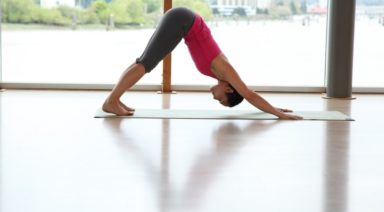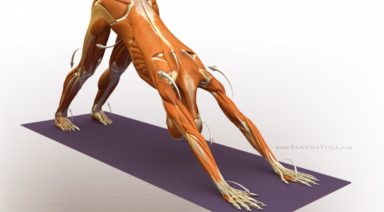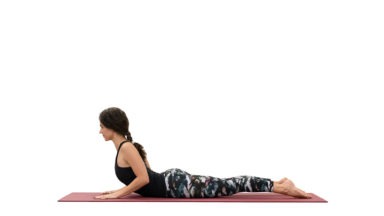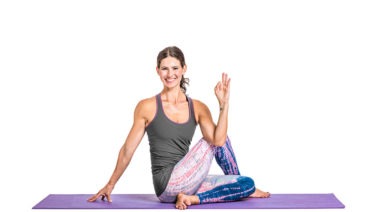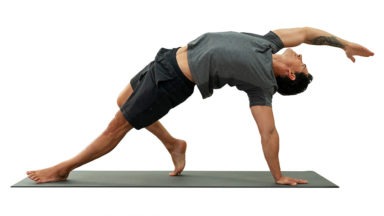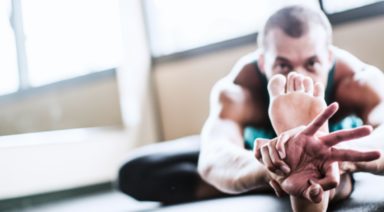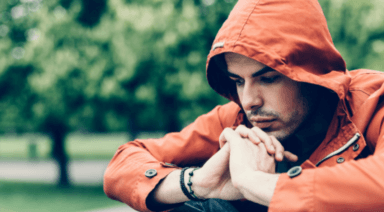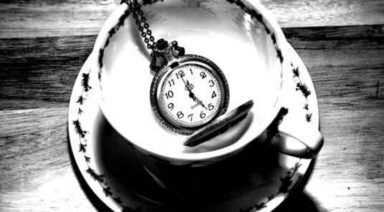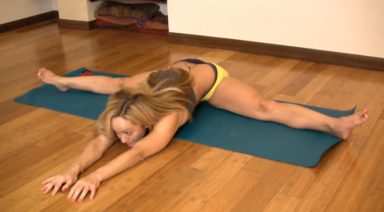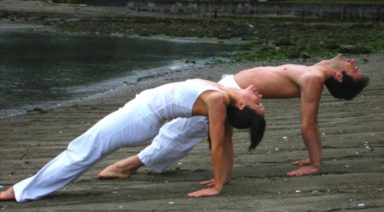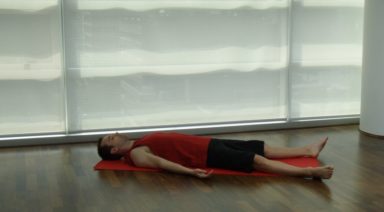5 Tips to Balance in Handstand

Almost no yoga pose brings as invigorating, fun and light-hearted joy as balancing in Handstand. When we can’t balance, though, it’s frustrating and a true test of yogic mindfulness. For the intermediate practitioner who’s already familiar with Adho Mukha Vrksanasa (Handstand), there’s a multitude of things to do to make balancing in it easier. These are a few favorites to get you away from the wall and out into the middle of the room.
- Stretch Your Legs and Hips First.
A crucial component to balancing in Handstand is to stack our center of gravity, in this case, the pelvis, over the balance point between our hands. Without limberness in the legs and hips, getting the pelvis up over the hands is much more difficult. It also requires more effort to kick up if we feel stiff and tight.
A few great yoga poses to open the legs and hips are: Uttanasana (Standing Forward Fold), Adho Mukha Shvanasana (Downward Dog), Parsvottanasana (Pyramid Pose), Adho Mukha Eka Pada Rajakapotasana (Downward Facing Pigeon Pose) and Supta Padangusthasana (Reclining Hand to Big Toe Pose).
- Squeeze Your Legs Straight.
Once we kick up into Handstand, we absolutely must bring our legs together and straighten them. Floppy legs and separated feet make Handstand feel heavy; the result places the workload too much into the arms. Powered up legs, squeezed together and reaching for the sky brings more of our bodies into the pose. It also creates length, lightness and openness in Handstand, all of which make it easier to balance.
- Work Your Hands and Feet.
The hands and feet are such small parts of our bodies, but what we do with them makes a huge impact on how long and easily we can balance in Handstand. First, we need to spread our fingers and toes so that we are fully alert and active in the posture. In our hands the weight will shift slightly between the fingers and from finger tips to heels of the hands.
To absorb the fluctuations in balance that we experience in Handstand, we have to allow for this subtle weight shift in the foundation. It’s also important, both for balance, as well as for the support of the wrists, to press down with each finger tip and all four corners of the palms simultaneously.
The feet mirror the hands and can be used to controlled and calm the normal oscillations that occur in Adho Mukha Vrksasana. Once you are up in the pose, act as if your feet are on the ceiling. Push up strongly through the soles of your feet and spread your toes to manage the wobbles that always come.
- Focus Your Vision.
Where we look in Handstand has a lot to do with our stability in the pose. If our eyes dart this way and that, it means our minds are wandering. Without focus and concentration, balance will be challenging. Look at the ground in between your hands, but slightly out in front of them. Your focal point on the ground draws an equilateral triangle; your hands form the bottom two points, where you are looking is the top point. If you tuck your chin and look between your arms it’s almost guaranteed that you’ll fall into a somersault.
- Learn to Fall Safely.
Nothing, when it comes to balancing in Handstand, will shut us down faster than the fear of falling. To keep our motivation high and our bodies safe, we must learn to fall out of Handstand without falling flat on our backs. The trick is to rotate the pelvis and windmill the legs over, one at a time, much like a cartwheel.
If you overshoot the pose, begin to shift your weight slightly more into one hand — whichever one feel most natural — than the other. Then, turn your hips out towards that side (i.e. if you leaned onto your right hand, turn your hips open to the right) and swing that leg (the right one, in this scenario) over. The second leg will follow and as it lands, shift the weight back into the feet and off the hands.
5 Yoga Poses to Improve Your Sex Life

If you are wondering what the connection is between yoga and sex you are not alone. Many people automatically think that there can’t be a connection there. But, it is important to know that yoga can help you have better sex. In fact, many people including fitness instructors, and medical professionals recommend yoga for improved intimacy.
What is important to remember is that being fit in general is likely to give you more self-confidence. When your self-confidence levels are high, your satisfaction in the bedroom will automatically increase. It will still actually increase even if the sex doesn’t change at all! How amazing is that? Practicing yoga and exercising in general can also provide a better awareness of your body. This is important to having a good sex life. You may notice things about your body when you practice yoga, or just stretch. You can begin to better understand your body, its flexibility, and your limits. This alone can help to improve your sex life.
The art of yoga relies on body awareness, body movement, and breathing. Many experts say that these three components are important to having healthy intimacy levels. In fact, did you know that by practicing yoga, your sex life will improve even if it wasn’t your goal or the main purpose for you taking up yoga?
As previously stated, when you have better body awareness, you are more likely to enjoy sex. Body awareness is one of the many foundations that yoga is built on. Being aware of your body can help to give you a better image of yourself, which can, in turn, increase your sex drive and ignite passion.
As for the breathing in yoga, it is so much more than just taking a breath while sitting on the couch at home. The breathing that yoga calls for actually helps to make your spine and your pelvis stronger. What does this mean for intimacy? It can result in better action and movement. You may find yourself being able to have sex longer. Your ability to try new sex positions also improves.
If your significant other isn’t currently practicing yoga, encourage them to try it! Practicing yoga together can also be quite rewarding.
Try these five poses to add a little zing to your sex life:
-
Wide-Legged Seated Forward Fold (Upavistha Konasana): Improves libido by increasing blood flow to the pelvic region.
-
Shoulderstand (Salamba Sarvangasana): Reverses blood flow, decreases anxiety and stress, relaxes mind and body.
-
Bound Angle Pose (Baddha Konasana): Helps to lessen PMS and menopause symptoms and promotes healthy functioning of the reproductive organs.
-
Cat/Cow (Marjaryasana): As you move through cat/cow, the kegel muscles strengthen as they work to control the tailbone. Strong, healthy kegel muscles produce better, more controlled orgasms.
-
Cobra (Bhujangasana): A, It’s a heart opener. The pose opens the heart chakra, opening it to the possibilities of love. B, It’s an energizing pose, which is good for those who are often too tired for sex.



